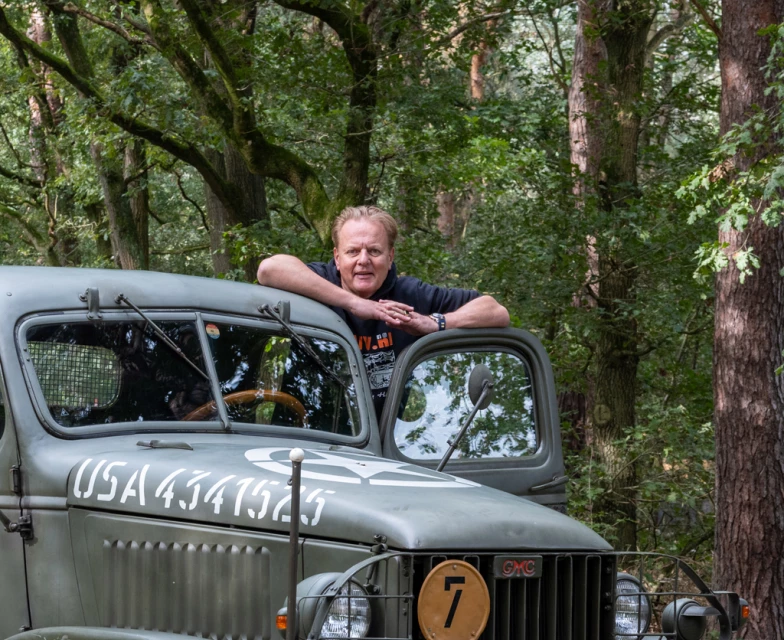Ivo Rigter Sr.
Fondateur et copropriétaire de BAIV et Tracksandtrade
+31 6 518 22 502 [email protected]Ce remarquable Sd.Kfz. 251 est une découverte rare, avec le numéro de châssis 813885, produit par Hanomag en 1943. Encore plus remarquable, il est équipé d'un moteur à numéros correspondants de la même année, préservant ainsi son authenticité. Découvert dans la région de Falaise en Normandie, on pense que ce véhicule a servi dans la 12ème Division SS Panzer durant la Seconde Guerre mondiale.
Le véhicule a subi une restauration de Classe A, le ramenant à un état "comme neuf". Lorsqu'il est correctement entretenu, ce Sd.Kfz. devrait fournir de nombreuses années de service fiable.
Il s'agit d'une occasion très rare de posséder un morceau d'histoire allemande de la Seconde Guerre mondiale, minutieusement restauré à sa gloire d'origine.
Ce remarquable Sd.Kfz. 251 est une découverte rare, avec le numéro de châssis 813885, produit par Hanomag en 1943. Encore plus remarquable, il est équipé d'un moteur à numéros correspondants de la même année, préservant ainsi son authenticité. Découvert dans la région de Falaise en Normandie, on pense que ce véhicule a servi dans la 12ème Division SS Panzer durant la Seconde Guerre mondiale.
La restauration de ce véhicule a été un processus méticuleux de démontage et de remontage, utilisant principalement des matériaux d'origine et adhérant strictement aux normes de guerre. Chaque détail, des écrous et boulons M8 de 14 mm aux grades de boulons de guerre comme 8G et 10K, a été fidèlement préservé. Les installations électriques et les tachymètres sont construits selon les spécifications exactes de 1943, tandis que l'intérieur et l'extérieur ont été restaurés pour refléter l'état de guerre du véhicule, y compris les chenilles moulées avec des caoutchoucs NOS d'origine et des pneus Continental de cette époque.
Le véhicule a subi une reconstruction complète du moteur, de la boîte de vitesses et du différentiel, le ramenant à un état "comme neuf". Lorsqu'il est correctement entretenu, ce Sd.Kfz. devrait fournir de nombreuses années de service fiable. Il s'agit d'une occasion très rare de posséder un morceau d'histoire allemande de la Seconde Guerre mondiale, minutieusement restauré à sa gloire d'origine.
The Sd.Kfz. 251 (Sonderkraftfahrzeug 251) half-track was a World War II German armored personnel carrier designed by the Hanomag company, based on its earlier, unarmored Sd.Kfz. 11 vehicle. The Sd.Kfz. 251 was designed to transport the Panzergrenadier (German mechanized infantry) into battle. Sd.Kfz. 251s were the most widely produced German half-tracks of the war, with at least 15,252 vehicles and variants produced by seven manufacturers. The utility of this vehicle led the German Army to develop the similar looking but shorter and lighter Sd.Kfz. 250 as a supplement.
Design
There were four main model modifications (Ausführung A through D), which formed the basis for at least 22 variants. The initial idea was for a vehicle that could be used to transport a single squad of 10 panzergrenadiers to the battlefield protected from enemy small arms fire, and with some protection from artillery fire. In addition, the standard mounting of at least one MG 34 or MG 42 machine gun allowed the vehicle to provide suppressive fire for the rifle squad both while they dismounted and in combat.
Armor
The armor plates were designed to provide protection against standard rifle/ machine gun bullets (like the 7.92×57mm Mauser bullet). The front-facing plates were 14.5mm thick; the sides were steeply angled, V-shape 8mm thick plates. This level of armor provided protection against normal (non-tungsten) rifle AP round, which could pierce about 8mm of vertical armor.
Open top
Positive aspects of the open top included greater situational awareness and faster egress by the infantry, as well as the ability to throw grenades and fire over the top of the fighting compartment as necessary while remaining under good horizontal cover. The downside, as with all armored personnel carriers of the era, was a major vulnerability to all types of plunging fire; this included indirect fire from mortars and field artillery, as well as small arms fire from higher elevated positions, lobbed hand grenades, Molotov cocktails, and strafing by enemy aircraft.
Models
The first two models (Ausf. A and B) were produced in small numbers from 1939. Ausf. A and B models can be identified by the structure of the nose armor, which comprised two trapezoidal armor panels - the lower of which had an engine cooling vent. The B model, which began production in 1940, eliminated the fighting compartment's side vision slits. The C model, which started production in mid-1942, featured a simplified hexagonal-shaped forward armored plate for the engine. Models A through C had rear doors that bulged out. The C model had a large production run, but was quite complex to build, involving many angled plates. From early 1943, the D model was developed with the purpose of halving the number of angled body plates, simplifying the design and thus speeding up the production. D models can be easily recognized by their single piece sloping rear, with flat doors.
Weapons
The standard personnel carrier version was equipped with a 7.92 mm MG 34 or MG 42 machine gun mounted at the front of the open compartment, above and behind the driver. A second machine gun could be mounted at the rear on an anti-aircraft mount. Variants were produced for specialized purposes, including with anti-aircraft guns, light howitzers, anti-tank guns and mortars or even large unguided artillery rockets, as well as a version with an infrared search light used to spot potential targets for associated Panther tanks equipped with infrared detectors.
Half-Track
A strong design feature of the Sd.Kfz. 251 was the large track area, with the characteristic "slack track" design with no return rollers for the upper run of track. The Sd.Kfz. 251 also had the Schachtellaufwerk system of overlapping and interleaved main road wheels common to virtually all German halftracks of the period. This lowered the ground pressure and provided better traction, at the cost of much greater complexity in maintenance. The Sd.Kfz. 251 also had tank steering, whereby the normal steering wheel moved the front wheels, but after more turning of the steering wheel, the tracks are braked to cause turning, like on a tank.
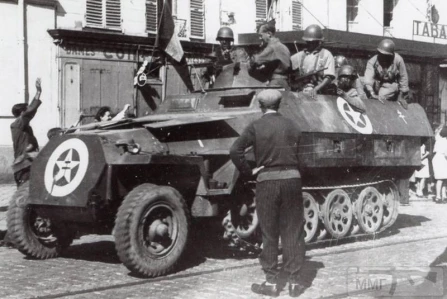
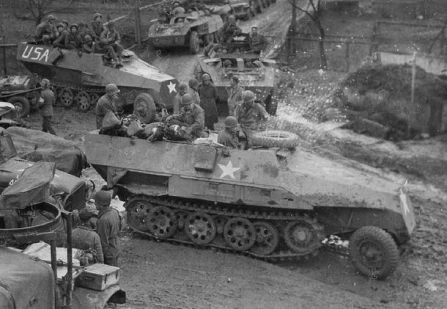
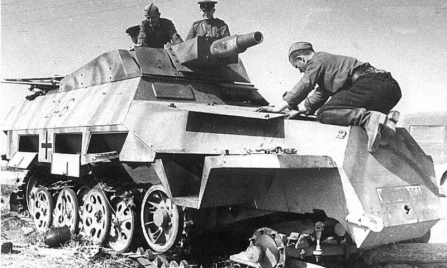
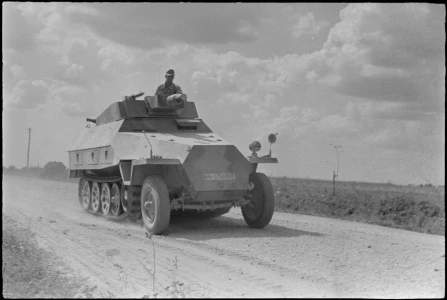

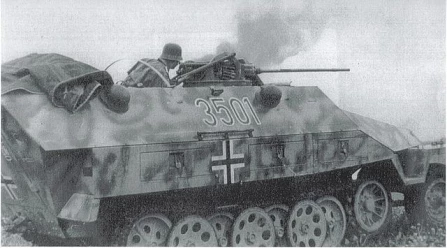
BUYER’S PREMIUM
On all lots a buyer’s premium of 16,5% of the hammer price is charged. Over this buyer’s premium a 21% sales tax (VAT) will be applicable.
PARTS, ACCESSOIRIES & MILITARIA
Spare parts, accessories and militaria are sold in as-is condition and delivered without any guarantee of functioning.
VEHICLES & VEHICLE RELATED EQUIPMENT
Cars, motorcycles, trucks, cannons or howitzers, armored vehicles, and tanks are sold in as-is condition, with no technical guarantee and guarantee of authenticity and with or without registration.
ARMS & WEAPONS
The Auction House will not supply ANY item unless the correct paperwork and licensing – if needed – has been supplied by the Buyer in full.
If required and applicable (fire)arms can be made inoperable or permanently disabled by BAIV in The Netherlands as being a licensed Arms & Weapons Dealer Registration Nr. NL20191618779. In this case all relevant cost will be charged to the Buyer in addition and have to be paid in advance in full. Collection by appointment only!
MARGIN/ VAT
However, for most of the lots 21% sales tax (VAT) over the hammer price will be not applicable, it might be that in some specific cases sales tax (VAT) over the hammer price will be charged. In such a case this will be specifically specified in the lot description. For all other lots the margin scheme will be applicable. For more info see our General Conditions of Sale Article 9 on our website; www.tracksandtrade.com
COLLECTION
Parts, accessories, and militaria
The collection of the lots, subject to payment, is by appointment only. The date and time for collecting the goods will be arranged in consultation with the seller.
Vehicles
Vehicles can be picked up, subject to payment, by appointment only. The date and time for collecting vehicles will be arranged in consultation with the seller.
Handling costs for the removal of the vehicles will, when applicable, be applied at cost.
Arms & weapons
The Auction House will not supply ANY item unless the correct paperwork and licensing – if needed - have been supplied in full. If required and applicable (fire)arms can be made inoperable or permanently disabled by BAIV in The Netherlands as being a licensed Arms & Weapons Dealer Registration Nr. NL20191618779. In this case all relevant cost will be charged to the Buyer in addition and have to be paid in advance in full. Collection by appointment only.
IMPORT & EXPORT
Depending on the destination and content of the Lot the Buyer shall obtain an International Import Certificate / End User Certificate. Some of the items listed in the auction may require special licenses or permits or existing documents must be prepared for export. If this is relevant, Tracks & Trade will take care of this. The applicable costs will be charged to the successful bidder. Please email [email protected] if you have any questions or concerns. No item will be allowed to be collected without 100% of all legal requirements being fulfilled.
DELIVERY
Removal of lots must be completed:
After full payment and 100% coverage of all legal requirements.
Within 6 weeks after the auction had ended (November 30, 2024). No storage fees will be applicable until that date.
Shipping and packing costs and special costs that arise for loading special items, such as crane costs or costs for hiring special equipment etc., will be charged to the Buyer on the basis of actual costs + a surcharge of 10%. Naturally, you can count on us when it comes to the shipment of your purchases. We are happy to take care of that.
STORAGE
Lots not picked up by Buyers within 6 weeks after the auction had ended (November 30, 2024) will be returned to secure storage at Buyer’s expense. In this case storage fees will be applicable. Contact Tracks & Trade for costs and conditions.
NOTE
If you have any specific questions, please contact us either by telephone (+31 6 518 22 502) or E-mail ([email protected]). We are happy to help and support you through the entire process. We will do our utmost to please and comfort you. So, don’t hesitate to contact us if you have any questions.
GENERAL CONDITIONS
All information and transactions are subject to the general terms and conditions (Version 2.0 dated 29-04-2022). For more detailed information visit our website.
After buying a classic military vehicle or other items such as cannons, planes, howitzers and tanks, there are several steps you would typically need to take:
Legalities
In principle, no special permit is required for unarmored wheeled and tracked vehicles. In many cases, an export procedure that is comparable to that for exporting classic cars and motorcycles is sufficient. Military collectables older than 75 years and with a value over Euro 50k are often considered National Heritage. In such cases an export permit must be requested from the National Ministry of Culture of the exporting country. Tanks, howitzers and self-propelled or towed cannons often require specific permits that are highly dependent on the country of shipment and the country of destination. In such a case first ensure that you apply for the necessary permits, licenses, and other paperwork required to own and operate such an item in your jurisdiction. This may involve registering the item with the appropriate authorities and complying with any regulations regarding its ownership and use. In such a case it is advisable to contact us in advance because we have many decades of experience in the import and export of Classic Military Heritage. Based on this experience, we can generally quickly provide feedback on what applies to you. This is especially relevant because regulations in this regard change every now and then and sometimes, we also have to deal with export-restrictions. In short: if you want to be sure, contact us in time to avoid difficulties in a later stage.
Storage
Find a suitable storage location for your collectable, preferably a secure and legal place where you can keep it when not in use. This could be a garage, warehouse, or even a specially designed storage facility or museum.
Transportation
After you have all paperwork in place next step will be the (oversees) transport to your desired location. This may involve hiring specialized transport and broker services due to permits, size and weight. Als in this case we can support you with organizing the transport or make sure you get in contact with some experts.
Maintenance and Restoration
Depending on the condition of your military collectable our partner BAIV can help you with maintenance and restoration work to ensure that it is safe and operational. This could involve relatively easy maintenance and repair, service till a Class-A restoration. In such a case please contact BAIV (link to BAIV website).
Training
If you intend to operate a vehicle then make sure you have manuals that describe how the operate vehicle. Nowadays there are numerous reprints available on the Internet that explain you in a playful way how to drive and operate your vehicle. This is often a team effort, which makes owning such a vehicle extra attractive. If required, you can also involve hiring a professional instructor or attending specialized training courses to learn how to drive and maintain it safely. In such a case, our partner BAIV can also support you.
Insurance
Consider obtaining insurance coverage for your vehicle to protect yourself against any potential accidents or liabilities that may arise from owning and operating it. Often there are specialized insurance companies offering these kinds of services. Local military vehicle clubs often also know their way around the specific options offered by insurance companies.
Enjoyment
Finally, once everything is in place, you can enjoy owning and, if permitted, operating your classic military vehicle, cannon or howitzer. Whether it's for display purposes or for participating in historical reenactments, owning such a great unit can be a unique and rewarding experience.
Ivo Rigter Sr.
Fondateur et copropriétaire de BAIV et Tracksandtrade
+31 6 518 22 502 [email protected]